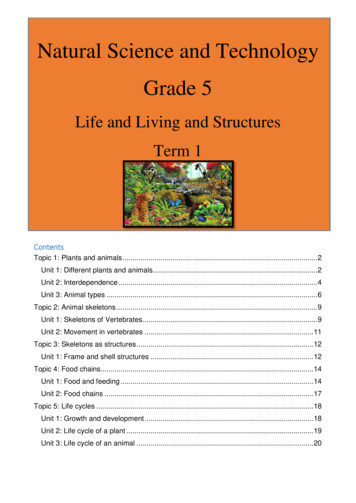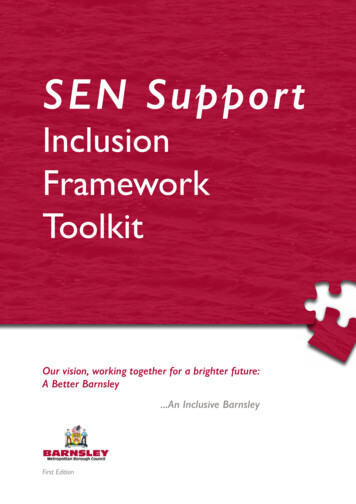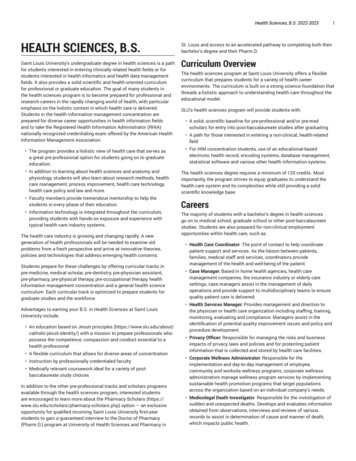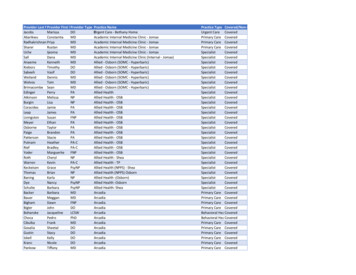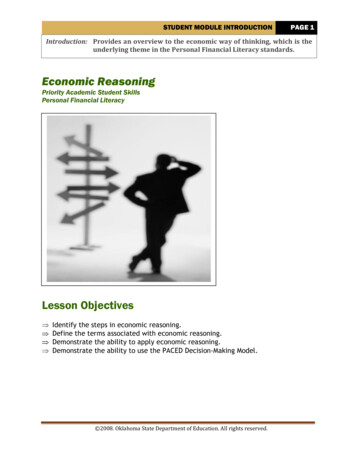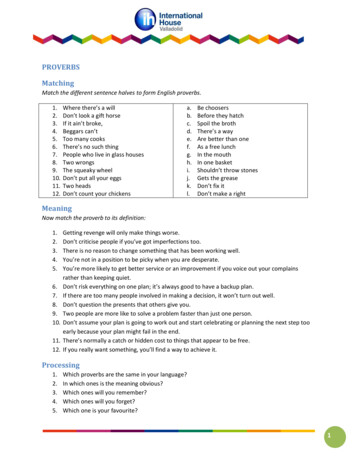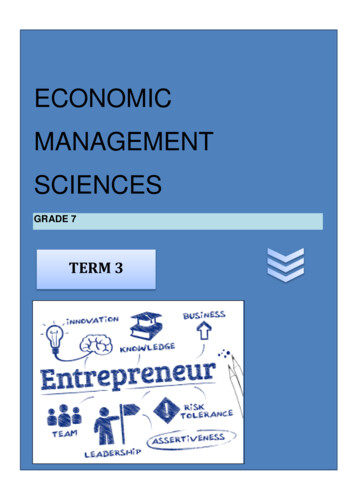
Transcription
ECONOMICMANAGEMENTSCIENCESGRADE 7TERM 3
1ContentsTOPIC 8: THE ENTREPRENEUR . 4Lesson 1 . 4Definition of an entrepreneur . 4What does it take to be an entrepreneur? . 4CHARACTERISTICS AND SKILLS OF AN ENTREPRENEUR . 5SKILLS OF AN ENTREPRENEUR:. 5Activity 1 . 6Lesson 2: Characteristics and skills . 6The characteristics of a successful entrepreneur . 6Case Study 1: Starting small, growing big . 6Activity 2: Characteristics of a successful entrepreneur . 7Lesson 3: Entrepreneurial actions of buying, selling, producing and making a profit . 8What action does an entrepreneur perform? . 8Entrepreneurial action of buying . 8Entrepreneurial action of producing. 8Entrepreneurial action of selling . 8Entrepreneurial action of making a profit . 9Activity 3 . 9Case Study 3 . 9Case Study 4 . 10Lesson 4: Starting a business . 10. 11Needs and wants, and consumer behaviour . 11Consumer Behaviour. 11Businesses and consumer behaviour . 11Activity 4 . 12Lesson 7: SWOT analysis and business goals . 13What is a SWOT analysis? . 13Setting and aching goals . 13Activity 5 . 14Lesson 8: Analysing, planning & setting business goals . 15Activity 8 . 15SWOT Analysis . 15Lesson 9: Advertising. 16Concept of advertising. 16Product . 16GM 2018
2Price. 16Place . 16Promotion . 16Media used for advertising . 16Print media: . 17Broadcasting media: R . 17Internet . 17Principals of advertising . 17Attention . 17Interest . 17Desire . 17Action . 17Activity 9: Analysing an advert . 17Homework activity . 18Lesson 10: Using recycled materials . 18Benefits of recycling . 19Recycling helps save energy . 19Recycling reduces pollution . 19Activity 10 . 19Lesson 11: Entrepreneurs Day . 20Topic 9: Poverty & Inequality . 20Lesson 12: The cause of socio-economic imbalance . 20What is inequality? . 21Inequality of income:. 21Inequality of opportunity: . 21What is poverty?. 21The poverty line: . 21The poverty cycle: . 21Economic inequality and its causes. 21Reasons for the difference in income: . 22Education and training: . 22Sexism: . 22Racism: . 22Personal preference: . 22Innate ability: . 22Nepotism: . 22Activity 12 . 22Lesson 13: (Formal Assessment – Research project) . 22GM 2018
3Inequality in South Africa. 22Socio economic inequality in South Africa. 23The Land Act of 1913 and 1936 . 23The Native Act of 1923 (Urban Areas). 23The Population Registration Act of 1950 . 24The Group Areas Act of 1950 (1966). 24The Bantu Authorities Act of 1951 . 24Activity 13 . 24Lesson 14: The need for education and skills . 25The relationship between low levels of education and poverty . 25Lesson 15: Urban and rural challenges . 26Urban Area . 26Rural Area . 26Socio-economic challenges in urban areas . 26Socio-economic challenges in rural areas . 26Activity 15 . 26Homework Research task . 27Creating sustainable job opportunities . 27Strategies to create employment include: . 27Activity 16 . 27GM 2018
4TOPIC 8: THE ENTREPRENEURPeople who take the risk to start new business are called entrepreneurs. They need tohave specific characteristics and skills to be successful in their new ventures. Successfulbusinesses start with a good idea. Entrepreneurs then use the entrepreneurial actions ofbuying and selling or producing to make a profit.Lesson 1Definition of an entrepreneurAn entrepreneur is a person who owns his own business. They can either start a businessor buy an existing business. Entrepreneurs work for themselves and create their own jobs.An entrepreneur takes a calculated risk by investing money in a business opportunity inorder to make a profit. They are people who can identify opportunities and have the skillsto turn an opportunity into a successful venture.What does it take to be an entrepreneur?It takes certain skills and personal characteristics to be a successfulentrepreneur. Not everyone is cut out be an entrepreneur.Anentrepreneur has to be able to live with uncertainty and be comfortabletaking risks. Some people are more comfortable working for otherpeople. They enjoy the security of earning a regular income at the endof every month.GM 2018
5CHARACTERISTICS AND SKILLS OF AN ENTREPRENEURTo be a successful entrepreneur a person needs certain personal characteristics andskills. It is not enough just to have a good business idea.Entrepreneurs need to have business knowledge, perseverance and determination.Entrepreneurs have many different characteristics of which a few have been definedbelow: Innovative – Entrepreneurs need to be able to think in a fresh way, have exciting ideasand sole problems creatively. Committed and dedicated – Entrepreneurs need to focus on their work so theirbusiness succeeds. Motivated and independent – Entrepreneurs need to be self-starters and make theirown decisions. Energetic – Entrepreneurs must have the energy to work hard for long hours. Risk taking – Entrepreneurs need to be prepared to take calculated risks or they willnot expand their businesses and move forward. Bold and courageous – Entrepreneurs need to see the problems they wil encounteras challenges, not obstacles.SKILLS OF AN ENTREPRENEUR: Communication – communicate well with clients and staff. Planning – know how to prepare for future, both long term and short term. Marketing – sell products ideas. Management – be able to direct people to complete tasks as efficiently as possible. Financial – be able to handle money wisely.GM 2018
6A very important entrepreneurial skill is the ability to think creatively. Entrepreneurs look atthings differently and find new ways to solve problems. Sometimes they change anexisting product, or find new ways to sell goods or services.Read the following case study to learn more about what it takes to make a success of abusiness venture and answer the questions that follow.Activity 11. Explain in your own words what an entrepreneur is.2. Look at the alphabet and select 6 of the most important skills that you think anentrepreneur should have and explain why.3. Do you think that you would enjoy being an entrepreneur? Give reasons for youranswer.Lesson 2: Characteristics and skillsThe characteristics of a successful entrepreneurCase Study 1: Starting small, growing bigAnthony Delport likes to try out new ideas and opportunities, especially those thatinvolve new technology. In 1990, Anthony and some friends started a company that istoday known as ‘Incredible Connection’. The company was listed in 1997 and isprobably one of the biggest computer retailers in South Africa. Anthony says that he hasbecome successful because he always learns from his mistakes. He believes that everyentrepreneur is unique, but that there are certain characteristics that are common to allsuccessful entrepreneurs.GM 2018
7According to Anthony, entrepreneurs should be enthusiastic and love what they do.However, they also need to be committed to achieving the goals of the business.To do this, they need to be determined, energetic and have an ability to complete tasks.One of an entrepreneur’s most difficult problems is that you usually have to try newideas more than once and experience failure before you reach success. This takes up alot of time.Entrepreneurs need to develop ideas that excite them. One of the hardest things anentrepreneur has to do, is never to give up. Once the entrepreneur has developed theidea, the next problem is finding the money to get the business going. Anthony believesthat you shouldn’t think that a big business is better than a small business. It is veryimportant to keep doing research.According to Anthony, you should concentrate on cash, not profits, when you start yourbusiness. You should focus on achieving your goals, but always be looking out for newbusiness ideas and opportunities.Finally, when you are successful, don’t forget the team who helped you create yourbusiness.Activity 2: Characteristics of a successful entrepreneur1. In the case study above, Anthony Delport mentions many different characteristics thatentrepreneurs need. Make a list of the characteristics of successful entrepreneurs.2. Explain what is meant by each of the following statements in the case study:a) Learn from your mistakes.b) Experience failure before you reach success.c) Find the money to get the business going and keep the business going.d) Keep doing research.e) Concentrate on cash, not profits.GM 2018
8Lesson 3: Entrepreneurial actions of buying, selling,producing and making a profitWhat action does an entrepreneur perform?Entrepreneurs have to do four things:1. Buy2. Sell3. Produce4. Make a profitEntrepreneurial action of buyingThe first basic functions that an entrepreneur has to perform, is buying or purchasingequipment, raw materials and stock. Different businesses need different kinds ofequipment to run a business. A business might need furniture, computer equipment,machinery or vehicles. This equipment is known as capital items.Entrepreneurial action of producingThe entrepreneurial action of producing includes all those activities that provide the goodsand services that consumers, businesses and the public sector want and for which theyare prepared to pay.Producing is the action of making the product. Producing involves taking raw materials andturning them into something useful that can be sold to customers. Producing is alsoreferred to as manufacturing or production. Not all businesses produce goods. Somebusinesses sell a service without making any physical product. Businesses that produceproducts are known as manufacturing businesses.Entrepreneurial action of sellingSelling is the action of persuading customers to buy a product or service. Selling involvesactivities such as advertising and marketing the product. It also involves talking tocustomers and explaining to them how the product works or the benefits of the products orGM 2018
9services. It is important that customers are satisfied with what they buy so that they comeback again.Entrepreneurial action of making a profitThe goal of owning a business is to make a profit. A business that does not make a profitwill have to close down. The entrepreneur will have to keep financial records to keep trackof the income and expenses of the business.Activity 3Read Case studies 3 and 4 to answer the questions below.1. An important characteristic of production is specializing. In what does Asandaspecialize and why?2. Asanda cuts costs by not throwing away the old bread that she did not sell. What doesshe do?3. Explain what the word “surplus” means and how Asanda uses it to make a profit.4. Explain what the entrepreneurial action of “making a profit” is and why it is essential instarting a business.5. Explain how an entrepreneur like Olwethu would use the factors of production to makea profit by buying and selling.6. What does Olwethu do, to ensure that she makes a profit?Case Study 3Asanda is an entrepreneur who lives in Etwatwa. She makes a living by baking breadand vetkoek for her neighbours and the local spaza shops. She started out when herprevious employer lent her money to buy a stove with an oven. To pay back the loanfaster, Asanda decided to bake some extra bread and sell it to her neighbours. Thesedays, it is her full-time occupation and she starts as early at 5am so that the first batch isready for breakfast time. Asanda works out what to charge for the bread based on whatit costs her to produce a loaf. This is known as the unit cost. Asanda only bakes breadand vetkoek as they always sell well and she does not have to worry about largequantities being left over at the end of the day, which will mean losing money. If shedoes have bread left over, she makes crumbs and sells it in bags to the spaza shops.Customers who are making meatballs or crumbed fish or meat buy the breadcrumbs.GM 2018
10Case Study 4Olwethu is a street vendor who trades in various goods near Benoni Railway Station.She buys and sells whatever she can find, at a good price. Early in the morning, hergoods include cold drinks and packets of chips for workers to take to the workplace.Towards evenings, she puts out vegetables, fruit, bread and milk as people head hometo their families. Olwethu visits the markets in the early morning and the wholesalers onthe weekends to buy her goods at a good price and in bulk. She then repackages theitems with the help of her children and adds her profit before selling the goods.To make enough money to live, Olwethu only keeps the profit. The rest of what shemakes is used to buy more goods every day. She does her research and knows whatthe various items sell for, all over town. She keeps a record in her little book. Shealways makes sure that she offers better prices than her competitors and has manyregular customers because of her friendly and efficient service. Together with a fewother retailers, she hires a local man and his bakkie to transport her goods to town.Lesson 4: Starting a businessStarting a business requires careful thought and planning. A business cannot survive if itdoes not make a profit. It will not be able to pay for goods and services that it needs tofunction. It will also not be able to pay any wages and salaries.In order for a business to make a profit, it must fulfil the needs and wants of customers.Business people must set goals with timelines and aim to achieve these with a careful planof action. If this is not done, the business will fail.GM 2018
11Needs and wants, and consumer behaviourNeeds and wants of consumersIt is important for an entrepreneur to realise that, although everybody has similar needs,their wants vary hugely. Needs are things people cannot live without. Wants are the luxuryitems we would like to have but which we can survive without.As an entrepreneur it is important to understand how consumers behave, so we canproduce items that they might be interested in buying. Some of the most importantinfluences on consumer’s choices are age, gender, career, financial position, culture andlifestyle.Consumer BehaviourBusinesses try to convince people to buy their products.Businesses advertise products in television adverts, posters,display boards, etc. For example, they may advertise a product byshowing “cool” people wearing fashionable clothes and using andenjoying their product. Businesses do not care whether peopleactually need the products that they buy; they just want consumers to buy their products.Clever consumers know that this is just a trick that businesses use to get people to buytheir products. Clever consumers buy things that they really need. They do not spend mostof their money on ‘unnecessary wants’. In this way, they save money that they can use toimprove their lives.Businesses and consumer behaviour Successful businesses study consumer behavior. Consumer behavior can beexplained as shopping habits. Once they learn about shopping habits of theirGM 2018
12customers, they can offer the products and services that most customers need andwant. These businesses know why their customers choose to buy certain products. Businesses that study consumer behaviour know, for example, that: Customers compare prices before buying. Customers normally buy from the shop with the lowest price You can ask a higher price if you are the only shop that sells a product in a certainarea. If your products are too expensive, customers will rather travel to another area wherethe product is cheaper. Shopping habits depend on the income of the consumers in the business area. Social groups (family, friends and cultural groups) influence shopping habits. Needs and wants are different at different times. Customers prefer to buy at shops that offer a friendly and helpful service.Activity 41) Name the four basic needs that people have.2) Why is it important for businesses to know about these needs?3) Give two examples each of clothes that are needs and clothes that are wants.4) Explain in table form, how the shopping habits of clever consumers differ from those ofother consumers.5) Give and explain four examples of consumer behaviour that businesses need to beaware of.GM 2018
13Lesson 7: SWOT analysis and business goalsWhat is a SWOT analysis?This type of analysis, called SWOT analysis, will guide you to reflect on your own personalstrengths and weaknesses, as well as the opportunities and threats the externalenvironment presents to your business.SWOT stands for strengths, weaknesses, opportunities and threats. A SWOT analysis willbe done to decide whether a business idea has the ability to be successful.Beforestarting a business, an entrepreneur first identifies a need of consumers and then thinks ofa business idea then analysis the strengths, weaknesses, opportunities and threats of thatbusiness.Strengths – consider what skills you have that could be used to make a successfulproduct.Weakness – the things we do not do well are our weaknesses.Opportunities – helps our business flourish.Threats – factors that may harm your business.Setting and achieving goalsA goal is a measurable end result of an intention or plan. When you have achieved yourgoal, you must be able to recognise it easily. To achieve goals, you have to work on themconstantly.GM 2018
14STRENGHTSStrengths are internal – it is what theowner of the business is good at.(personalqualities,positivecharacteristics.You are able to talk to people easilytherefore you will have a goodrelationship with your customers.High standards – business will producehigh quality products.Staff have excellent training.Business has a large number of loyalcustomers.OPPORTUNITIESOpportunities are external and comefrom outside the business environment.Opportunities are chances that you canuse in order to improve the position thatyou are in.Example – you think of a new productthat is not being sold in your area.There are very few other companiesmaking the product.The factory or business has anexcellent location.The demand for the product isincreasing.WEAKNESSESWeaknesses are also internal. It is allthe things that the owner or business isnot good at doing. Weaknesses arethings that we can control and try toovercome.The owner does not have the skills orknowledge to run a business.The owner does not have experience inmanaging a business.Not enough capital to buy the bestmachinery or pay for excellent staff.THREATSThreats are external and come fromoutside the business environment.Threats are things that have a negativeeffect on you, your idea or yourbusiness. These are things that yourbusiness cannot control.New labour law makes it difficult toemploy more staff.Other businesses copying the product.Cheaper versions of the product beingimported. (e.g. from China)Petrol price increase means the costsof your product is going to increase.Activity 5Imagine that you have opened a clothing shop in a new shopping mall. Draw the SWOTanalysis grid in your workbooks with the correct headings.Identify at least two strengths, weaknesses, opportunities and threats that your clothingbusiness may have to take into account in the shopping mall.GM 2018
15Lesson 8: Analysing, planning and setting businessgoalsActivity 8In pairs, complete a SWOT analysis based on one of the case studies der the following points when completing your SWOT analysis:1. Is there a demand for this product or can one be created?2. How much capital is needed to start this business?3. Is there competition from others selling a similar product?4. How will Kevin & Britney get the raw materials and deliver the finished product?5. Is the business able to grow? If so, how? What type of employees will be needed?6. What resources will both businesses need? (Premises, water, electricity, etc.)7. What skills do both Kevin and Britney have? What will they have to learn or outsource?SWOT AnalysisUse one of the Case Studies to complete your SWOT analysis.Case Study 1 – Setting up a music businessKevin is about to set up a business manufacturing and selling traditional musicalinstruments. He is a musician himself and has a great deal of experience in playingand making instruments, including drums and xylophones. He intends to employtwo other people to help him make these instruments and plans to sell them at abusy craft market in Boksburg. This craft market is a popular tourist attraction.Case Study 2 – Setting up a baking businessBritney Smith, a Grade 9 learner from Benoni, has developed a novel idea of makingbiscuits covered in the flags of different countries. She gets the flags printed on ricepaper so that the whole biscuit is edible. She then heat-seals the biscuits into seethrough plastic bags and includes a card with interesting information about thecountry whose flag is displayed. Britney has named the business Flagos.Britney plans to sell her biscuits and a food market every Saturday.GM 2018
16Homework activityGo through magazines, newspapers or pamphlets and bring 3 or 4 differentadvertisements on different products or services for Lesson 9.Look at Lesson 9 and Activity 9 to help you with your selection of an appropriateadvertisement.Lesson 9: AdvertisingConcept of advertisingMarketing means developing ways to increase the number of sales for a product.Marketing looks at the four P’s which are:Product – What are you going to do that makes your prod
Entrepreneurial action of producing The entrepreneurial action of producing includes all those activities that provide the goods and services that consumers, businesses and the public sector want and for which they are prepared to pay. Producing is the action of making the product. Producing involves taking raw materials and

